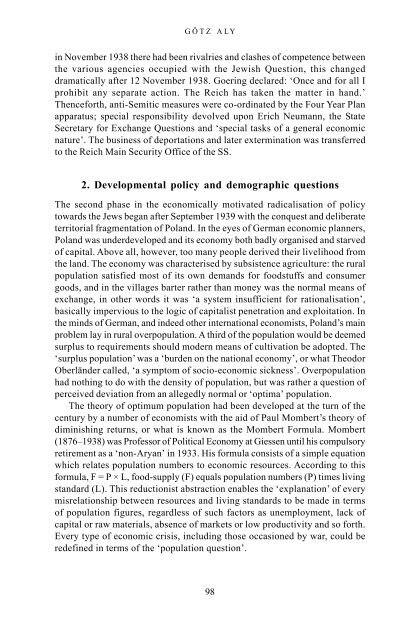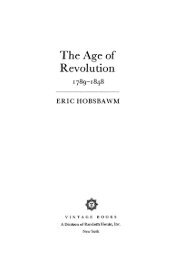The_Holokaust_-_origins,_implementation,_aftermath
The_Holokaust_-_origins,_implementation,_aftermath
The_Holokaust_-_origins,_implementation,_aftermath
You also want an ePaper? Increase the reach of your titles
YUMPU automatically turns print PDFs into web optimized ePapers that Google loves.
GÖTZ ALY<br />
in November 1938 there had been rivalries and clashes of competence between<br />
the various agencies occupied with the Jewish Question, this changed<br />
dramatically after 12 November 1938. Goering declared: ‘Once and for all I<br />
prohibit any separate action. <strong>The</strong> Reich has taken the matter in hand.’<br />
<strong>The</strong>nceforth, anti-Semitic measures were co-ordinated by the Four Year Plan<br />
apparatus; special responsibility devolved upon Erich Neumann, the State<br />
Secretary for Exchange Questions and ‘special tasks of a general economic<br />
nature’. <strong>The</strong> business of deportations and later extermination was transferred<br />
to the Reich Main Security Office of the SS.<br />
2. Developmental policy and demographic questions<br />
<strong>The</strong> second phase in the economically motivated radicalisation of policy<br />
towards the Jews began after September 1939 with the conquest and deliberate<br />
territorial fragmentation of Poland. In the eyes of German economic planners,<br />
Poland was underdeveloped and its economy both badly organised and starved<br />
of capital. Above all, however, too many people derived their livelihood from<br />
the land. <strong>The</strong> economy was characterised by subsistence agriculture: the rural<br />
population satisfied most of its own demands for foodstuffs and consumer<br />
goods, and in the villages barter rather than money was the normal means of<br />
exchange, in other words it was ‘a system insufficient for rationalisation’,<br />
basically impervious to the logic of capitalist penetration and exploitation. In<br />
the minds of German, and indeed other international economists, Poland’s main<br />
problem lay in rural overpopulation. A third of the population would be deemed<br />
surplus to requirements should modern means of cultivation be adopted. <strong>The</strong><br />
‘surplus population’ was a ‘burden on the national economy’, or what <strong>The</strong>odor<br />
Oberländer called, ‘a symptom of socio-economic sickness’. Overpopulation<br />
had nothing to do with the density of population, but was rather a question of<br />
perceived deviation from an allegedly normal or ‘optima’ population.<br />
<strong>The</strong> theory of optimum population had been developed at the turn of the<br />
century by a number of economists with the aid of Paul Mombert’s theory of<br />
diminishing returns, or what is known as the Mombert Formula. Mombert<br />
(1876–1938) was Professor of Political Economy at Giessen until his compulsory<br />
retirement as a ‘non-Aryan’ in 1933. His formula consists of a simple equation<br />
which relates population numbers to economic resources. According to this<br />
formula, F = P × L, food-supply (F) equals population numbers (P) times living<br />
standard (L). This reductionist abstraction enables the ‘explanation’ of every<br />
misrelationship between resources and living standards to be made in terms<br />
of population figures, regardless of such factors as unemployment, lack of<br />
capital or raw materials, absence of markets or low productivity and so forth.<br />
Every type of economic crisis, including those occasioned by war, could be<br />
redefined in terms of the ‘population question’.<br />
98



